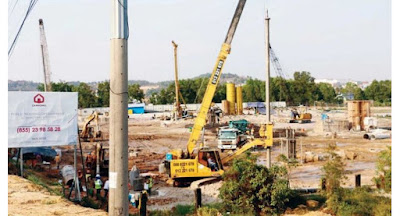A beach in the Mekong River in Kratie province
The province of Kratie, in the country’s east, is poised to become a priority tourist destination and a national heritage site.
Tourism Minister Thong Khon on Monday unveiled plans to turn the province’s capital into a “prime tourism destination” and a “heritage city”.
Prime destinations are important attractions but are not as crucial to the tourism sector as the country’s main tourist draws – the Angkor Archaeological Park in Siem Reap and the coastal areas.
Tourism Minister Thong Khon on Monday unveiled plans to turn the province’s capital into a “prime tourism destination” and a “heritage city”.
Prime destinations are important attractions but are not as crucial to the tourism sector as the country’s main tourist draws – the Angkor Archaeological Park in Siem Reap and the coastal areas.
Minister Khon said the decision to turn Kratie into a priority destination and a heritage site was based on the city’s many tourist attractions, particularly the dolphins that can be spotted in the Mekong River.
“If there are dolphins in the Mekong River, there are tourists; however, no dolphins, no tourists,” Mr Khon said.
Other noteworthy products and sites in the province with great tourism potential include the Koh Trong pomelo, colonial buildings, stunning river beaches, and a slew of eco-tourism sites, the minister said.
He reminded the city’s authorities of their responsibility to boost the quality of these products and sites to meet and exceed tourists’ expectations.
“We must continue improving the quality of services and products in the province and create new tourism products,” he said. “We must work hard to develop Kratie province into a prime destination and a heritage site, organise new events on the beach and in the river, keep the city and the province clean, improve hygiene in public toilets, and protect the environment,” Mr Khon said.
“If there are dolphins in the Mekong River, there are tourists; however, no dolphins, no tourists,” Mr Khon said.
Other noteworthy products and sites in the province with great tourism potential include the Koh Trong pomelo, colonial buildings, stunning river beaches, and a slew of eco-tourism sites, the minister said.
He reminded the city’s authorities of their responsibility to boost the quality of these products and sites to meet and exceed tourists’ expectations.
“We must continue improving the quality of services and products in the province and create new tourism products,” he said. “We must work hard to develop Kratie province into a prime destination and a heritage site, organise new events on the beach and in the river, keep the city and the province clean, improve hygiene in public toilets, and protect the environment,” Mr Khon said.
.
.
“Tourism officials must also strive to improve tourist boats so that they offer a quality service, and drivers must wear proper uniforms,” he added.
Mr Khon told Kratie’s provincial tourism department to focus on revamping infrastructure like tourist booths, parking areas, and public toilets while improving services and products at stores, tourist boats, restaurants, and food courts.
Chuk Chumnor, spokesperson for the Ministry of Tourism, told Khmer Times that the government also wants to turn Battambang and Kampot into heritage sites. He said the ministry is working with Unesco to register these cities as national heritage sites first, and world heritage sites at a later stage.
“We are also working with Unesco to register Kratie city as a heritage site, together with Battambang and Kampot. These three cities boast beautiful French buildings,” Mr Chumnor said.
“We are committed to strengthening the quality of tourism services and products, social order and security as well as improving eco-tourism sites in the province,” Mr Chumnor said.
Mr Khon told Kratie’s provincial tourism department to focus on revamping infrastructure like tourist booths, parking areas, and public toilets while improving services and products at stores, tourist boats, restaurants, and food courts.
Chuk Chumnor, spokesperson for the Ministry of Tourism, told Khmer Times that the government also wants to turn Battambang and Kampot into heritage sites. He said the ministry is working with Unesco to register these cities as national heritage sites first, and world heritage sites at a later stage.
“We are also working with Unesco to register Kratie city as a heritage site, together with Battambang and Kampot. These three cities boast beautiful French buildings,” Mr Chumnor said.
“We are committed to strengthening the quality of tourism services and products, social order and security as well as improving eco-tourism sites in the province,” Mr Chumnor said.
.
.
Thoun Sinan, chairman of the Cambodian chapter of the Pacific Asia Travel Association, said the priority destination scheme is a strategy that aims to increase opportunities for socioeconomic development through tourism investment and development.
“To develop these priority destinations, the Ministry of Tourism, in close cooperation with the Ministry of Culture and Fine Arts and Unesco, has studied and produced the necessary documentation to register these cities as national heritage cities and Unesco world heritage sites.
“Battambang, Kampot, and Kratie could become world heritage sites, which will draw public attention to them and help develop them in a sustainable manner while preserving their urban and natural heritage,” Mr Sinan said.
Last year, Kratie province welcomed about 349,000 visitors, a 15.2 percent year-on-year increase. 25,990 of them were foreigners, mostly French nationals, according to the Ministry of Tourism.
“To develop these priority destinations, the Ministry of Tourism, in close cooperation with the Ministry of Culture and Fine Arts and Unesco, has studied and produced the necessary documentation to register these cities as national heritage cities and Unesco world heritage sites.
“Battambang, Kampot, and Kratie could become world heritage sites, which will draw public attention to them and help develop them in a sustainable manner while preserving their urban and natural heritage,” Mr Sinan said.
Last year, Kratie province welcomed about 349,000 visitors, a 15.2 percent year-on-year increase. 25,990 of them were foreigners, mostly French nationals, according to the Ministry of Tourism.
Source - Khmer Times










































